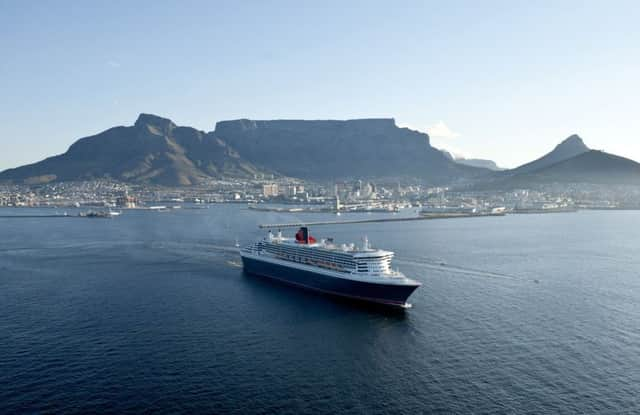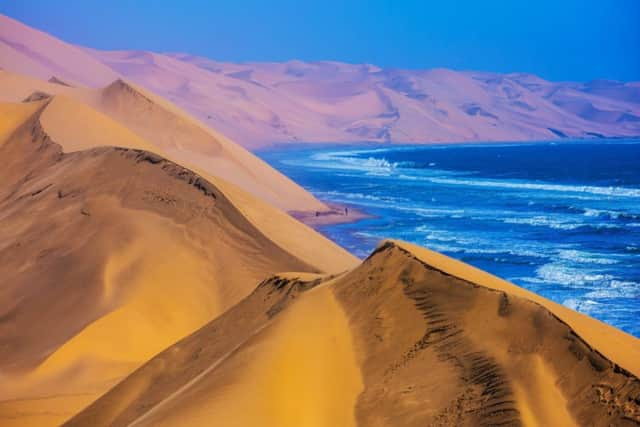Travel: Cruise to Cape Town


None the less, the 17 days it would take to get to there was a slight worry. Would we be bored? Would we have cabin fever? We trusted to luck, and Cunard, and sailed away.
The ship was the newest of Cunard’s fleet, the Queen Elizabeth. Very spick and span, and with a woman captain, Inger Thorhauge, a native of the Faroe Islands. We heard various comments, from Englishmen, of the genus “will she be able to park it?” “will we get lost?”, proving once again that dinosaurs do walk the earth, and I hoped that none of them suffered any medical emergency, when they would have found that the ship’s doctor, an Orcadian, was also a woman.
Advertisement
Hide AdWe didn’t get lost, and the captain had the priceless gift of the most reassuring and confident tone of voice, so her daily bulletins would have surely soothed the most nervous passenger. Even in the choppy Bay of Biscay, all was fine, all was to be expected and coped with. So we sailed on to those winter sun islands; Tenerife, Gran Canaria, and Madeira. The first two were as Spanish as we anticipated, and Madeira, rightly famous for its gardens, was, as it always is, serenely Portuguese. Like Scotland and England these close neighbours have an entirely different flavour.


As we travelled down the coast of Africa, the weather grew warmer and there were ever more warnings about exposure to the strength of the African sun on deck.
We even sailed close to St Helena – we were supposed to visit the island, but weather conditions forbade it. Probably similar weather conditions to those which are threatening the opening of the expensive airport there. So we sailed around what is essentially a large rock in the South Atlantic, utterly isolated, and the perfect place if you wanted to confine a latter-day Napoleon to ensure he would have no hope of escape. It did feel bleak – far removed from France and all the glories that had been – and the emperor must have despaired as he reached the end of his life in such a place.
After seeing a variety of spectacular sea birds and even flying fish on our voyage, we reached the Skeleton Coast and our first African landfall, Namibia.
“This is the real Africa” said our guide as we drove along the coast from Walvis Bay seeing seals, pelicans and flamingos, to the huge dunes of the desert, where some intrepid souls were climbing up the soft sand – one step forward, two steps back, but eventually making it to the top. The desert gave way to Swakopmund, or German town as it is known in South Africa. And indeed, we could have been in Bavaria to judge by the black and white half timbering of the German-style buildings, although the history here is not so charming, as we found in the town museum. This part of the German empire was the scene of the first genocide of the 20th century when the administration wiped out 50% of the native population. Later the British government took over and gave Namibia to South Africa, with the country only gaining its independence in 1990. Not surprising then that the bare-breasted women traders in the market place seemed somewhat wary.


Now we were ready for South Africa, for sailing into Cape Town and the dramatic backdrop of Table Mountain. We had made it, in 17 days, and we hadn’t been bored; we had run out of time to do all the things the Queen Elizabeth offered. We had eaten too much, of course, not least in the speciality restaurant, The Verandah, which was so French in its menu and flawless execution that I had to keep looking out of the porthole to assure myself we were definitely at sea. We had also drunk too much, of course, and been entertained by guest speakers, among them sports presenter Clare Balding and writer Bill Bryson, both very entertaining, especially the former – when she recalled Princess Anne in her “big knickers” rebuking the presenter in the changing rooms after she had dared to beat the royal in a horse race.
Advertisement
Hide AdWe had tried dance classes, bridge classes, computer classes, treatments in the spa, but hadn’t time for the karaoke, quizzes, croquet, tennis or all of the concerts. We watched in wonder at the expert dancing of some passengers (one Japanese couple, whether at the gala balls or other evenings, looked very professional, and she with at least 17 ball gowns).
We loved the music that accompanied so many occasions, particularly the string quartet, and above all, the harpist, who made afternoon tea lyrical, and we listened as the passengers formed a choir, which rehearsed and rehearsed and gave a wonderful performance just as we rounded The Cape. That performance unfortunately competed with the Grand Afternoon Tea in the Britannia Restaurant, transformed with buffet tables set with amazing ice sculptures – including Tower Bridge – and endless sandwiches and savouries, cakes and pastries, and a man on the crêpe suzette station who had a wonderfully generous hand with the Grand Marnier.
Advertisement
Hide AdWe also took the ship’s tour; seeing backstage in the theatre, the entirely computer driven engine room, the safety and security aspects, the medical centre, where we encountered the ship’s doctor, and finally the bridge and the captain.
She even let me sit in her chair and fantasise that I could take command. It was only make-believe, of course, but that’s what a Cunard cruise, from the fireworks at Southampton to the docking in sight of Table Mountain, feels like.